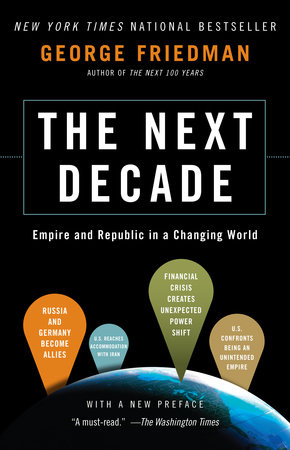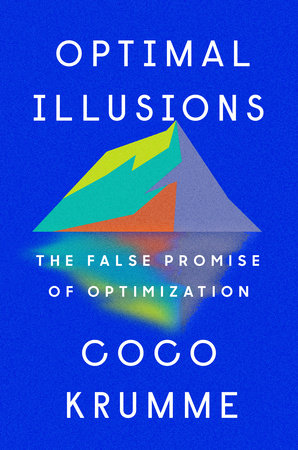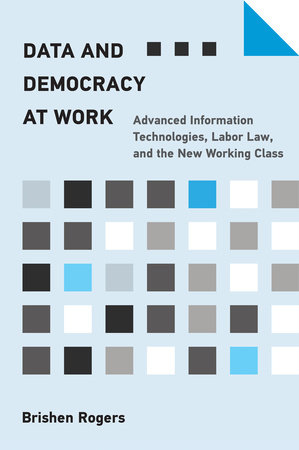Quick Summary
One Sentence Summary
In “The Next Decade,” George Friedman offers a provocative forecast of the geopolitical shifts and challenges that will shape the world in the upcoming ten years.
Big Idea
Friedman argues that the 2020s will be a crucial decade, characterized by significant realignments in global power dynamics, with a focus on how the United States will navigate its role as a superpower amid emerging challenges.
Five Key Ideas
- Shifting Power Balance: The book delves into the changing balance of power among nations, emphasizing the rise of new players and the decline of others.
- Technological Advancements: It explores the impact of technology on global politics, economics, and society.
- Economic Shifts: Friedman examines the potential economic shifts and crises that could redefine global trade and finance.
- Geopolitical Strategies: The book outlines the strategic moves and counter-moves expected from key global players.
- Domestic vs. International Tensions: It discusses the tension between domestic policies and international responsibilities that nations, particularly the U.S., will face.
Actionable Advice
Readers are encouraged to think critically about global affairs, understanding that the decisions made by world leaders are often complex and driven by a multitude of factors, not just ideology.
About the Author
George Friedman is a geopolitical forecaster and strategist, known for his previous works such as “The Next 100 Years” and his role as the founder of Stratfor, a private intelligence and forecasting company.
Read Next
For further insights into global affairs, consider reading “The Next 100 Years” by George Friedman for a broader perspective, “Prisoners of Geography” by Tim Marshall for an understanding of how geography shapes global politics, and “The Clash of Civilizations” by Samuel P. Huntington for a different take on global cultural and political divisions.
In Depth
Shifting Power Balance
The 21st century has witnessed a seismic shift in global power dynamics. In “The Next Decade,” George Friedman dives into these transformations, predicting how they will unfold in the 2020s. Nations are on a chessboard; some rise, others fall. This period is marked by the emergence of new powers and the decline of traditional ones.
Friedman meticulously analyzes the rise of countries like China and India. He notes how their economic growth and increasing geopolitical influence will redefine global power structures. China, particularly, receives significant attention. Its journey from a closed, impoverished nation to a global economic powerhouse is a focal point.
The decline of European influence is another critical aspect. Friedman points out how internal divisions and economic challenges might cause Europe to lose its grip on global affairs. This decline isn’t just economic but also political and cultural.
A detailed example is the U.S.-China relationship. Friedman delves into how the U.S. might approach China’s rise. He foresees a complex dance of competition and cooperation. The U.S., while acknowledging China’s growth, would strategically work to prevent it from dominating Asia. This balance of power game is not just military but also economic and diplomatic.
Friedman states:
“The United States will have to accommodate and contain China at the same time, a complex and nuanced strategy requiring a level of sophistication that American foreign policy hasn’t always shown.”
This quote encapsulates the delicate balancing act the U.S. must perform. It’s not about outright confrontation or complete accommodation. It’s about navigating a middle path, ensuring U.S. interests while acknowledging China’s ascent.
Russia’s role in this decade also comes under scrutiny. Once a superpower, Russia now seeks to regain some of its lost influence. Friedman discusses how Russia’s energy resources and strategic positioning give it leverage, albeit limited compared to its Soviet-era power.
Another layer to this shifting balance is the role of smaller nations. Countries like Turkey, Iran, and Brazil get attention. These nations, according to Friedman, have regional clout and could become pivotal in their respective areas. Their decisions could significantly impact regional power dynamics.
Friedman’s analysis doesn’t just stop at nation-states. He delves into non-state actors, like multinational corporations and international organizations, and how they influence the power balance.
In essence, “The Next Decade” paints a picture of a world in flux. Power is not static; it’s continuously shifting. Old powers wane; new ones rise. This dance of power isn’t just about military might but encompasses economics, technology, diplomacy, and even culture. Understanding these shifts, as Friedman eloquently presents, is crucial to grasping the future of global politics.
Technological Advancements
In a world where technology evolves at a breakneck pace, its impact on geopolitics is profound. In “The Next Decade,” George Friedman keenly observes how technological advancements will redefine global interactions. This shift isn’t just about gadgets; it’s about power, influence, and survival.
Friedman emphasizes the role of technology in reshaping economies and military capabilities. He points out that nations at the forefront of technological innovation will have a significant edge. This advantage extends beyond mere economic gains; it shapes global influence and security dynamics.
A pivotal example from the book is the role of cyber warfare. Friedman discusses how cyber capabilities have become crucial elements of national security. He explains that the ability to defend against cyber-attacks or to deploy them effectively could determine a nation’s standing in the international arena.
“In the next decade, we will see the emergence of a new kind of warfare, one that happens in the cyber realm. This will fundamentally change how wars are fought and how nations protect themselves.”
This quote highlights the paradigm shift in warfare and security. Traditional military might is no longer the sole determinant of a nation’s power. The cyber domain introduces a new battlefield, one that is invisible yet omnipresent.
Friedman also delves into the impact of technological advancements on social dynamics. He talks about the rise of social media and how it influences public opinion, political movements, and even government policies. The Arab Spring is cited as an example, showcasing how technology can fuel political change.
The democratization of technology is another key point. Friedman points out that advanced technology is no longer the exclusive domain of wealthy nations. Smaller countries and even non-state actors can access potent technological tools, leveling the playing field in some respects.
Friedman discusses the challenges that come with technological advancements. Privacy concerns, ethical dilemmas regarding artificial intelligence, and the potential for technology to widen socio-economic gaps are some of the issues he raises.
Furthermore, he examines the role of technology in economic shifts. Nations leading in technological innovation are likely to see economic growth. However, this also leads to disruptions in traditional industries and job markets. Friedman underscores the need for nations to adapt to these changes to remain competitive.
In sum, technology in “The Next Decade” is portrayed as a double-edged sword. It’s a catalyst for progress and power but also a source of new vulnerabilities and challenges. Understanding its multifaceted impact is essential for grasping the future geopolitical landscape, as Friedman astutely observes.
Economic Shifts
Economic power is a pivotal chess piece in the global arena. In “The Next Decade,” George Friedman offers a comprehensive look at how economic shifts will reshape the world stage. He identifies pivotal trends and their potential impact, emphasizing that economic strategies are as vital as military tactics in global dominance.
A profound example Friedman explores is the changing nature of global trade. He discusses the potential for major shifts in trade alliances and patterns. Specifically, he points to China’s economic rise and how its approach to global trade might evolve. Friedman suggests that China could shift from being the world’s factory to focusing more on its domestic market and regional trade.
“The China that was once the cornerstone of global manufacturing might start looking inward, and this will have ripple effects on global trade dynamics.”
This quote underscores the significance of China’s economic decisions. A shift in its trade policies could disrupt established supply chains and challenge other nations to adapt.
Friedman doesn’t just focus on the giants. He delves into how smaller economies might navigate these changing tides. He talks about the potential for regional trade blocs to gain prominence, offering smaller nations a chance to leverage collective bargaining power.
Another key economic shift Friedman discusses is the potential for financial crises. He warns that the global financial system, interconnected yet fragile, could face significant stressors. These could stem from national debts, currency fluctuations, or shifts in investment patterns.
Friedman also touches on the impact of technology on economies. He discusses how automation and artificial intelligence could transform job markets, leading to both opportunities and challenges. Nations that can harness these technologies might leap ahead, while others could struggle with unemployment and social unrest.
Energy is another focal point. Friedman explores how shifts in energy production and consumption could alter geopolitical alliances. The rise of renewable energy, changes in oil markets, and energy independence are topics he delves into. These shifts, according to Friedman, could redistribute economic power globally.
Friedman also brings attention to the intersection of economic and political strategies. He suggests that nations will increasingly use economic tools—like sanctions, trade agreements, and investment policies—as extensions of their geopolitical strategies.
Inflation and its global implications are not overlooked. Friedman talks about how inflationary pressures could destabilize economies and lead to political turmoil. He suggests that managing inflation will be a critical task for governments.
In essence, Friedman’s analysis of economic shifts paints a picture of a world in economic flux. The next decade, as he sees it, will be marked by significant changes in how nations interact economically. These shifts are not just about wealth; they’re about power, influence, and survival on the global stage. Understanding them, as Friedman meticulously does, is key to understanding future geopolitical dynamics.
Geopolitical Strategies
In a world where power is constantly shifting, understanding geopolitical strategies is crucial. George Friedman, in “The Next Decade,” dissects the strategic maneuvers nations may employ to secure their interests. He illuminates the chess game of international politics, where moves and counter-moves define the global order.
Friedman presents a detailed analysis of the United States’ strategies. He discusses how the U.S., as a superpower, must navigate complex global relationships. The U.S. strategy, according to Friedman, will involve balancing relationships with emerging powers while maintaining its dominance.
“The United States will be engaged in a delicate balancing act, fostering relationships with rising powers but also ensuring that no single power, or coalition of powers, can threaten U.S. interests.”
This quote captures the essence of U.S. strategy as envisioned by Friedman. It’s about striking a balance, ensuring stability, and avoiding the emergence of a singular, threatening power.
A specific example from the book is the U.S. strategy towards Russia. Friedman delves into how the U.S. might approach Russia’s ambitions to regain some of its lost influence. He suggests that the U.S. strategy could involve a combination of containment and engagement, recognizing Russia’s regional importance but limiting its global reach.
Friedman doesn’t limit his analysis to superpowers. He discusses the strategies of regional powers like Turkey and Iran. He suggests that these nations will seek to expand their regional influence, employing a mix of diplomatic, economic, and military tactics.
The strategy of forming and dissolving alliances is another theme Friedman explores. He suggests that nations will increasingly engage in temporary alliances, formed based on specific interests rather than long-term commitments. This fluid approach to alliances, according to Friedman, will be a hallmark of the next decade’s geopolitics.
Friedman also discusses the strategies of non-state actors. He talks about how multinational corporations and international organizations will pursue their agendas, often influencing state policies. Their strategies, while different in nature, will impact the global geopolitical landscape.
The use of soft power is another strategic tool Friedman addresses. He discusses how nations will use cultural, economic, and diplomatic means to extend their influence. This soft power approach, according to Friedman, will often complement harder military strategies.
Friedman also touches on the strategy of information warfare. He suggests that nations will increasingly use information as a tool to shape perceptions, influence foreign populations, and gain strategic advantages.
In essence, Friedman’s exploration of geopolitical strategies offers a window into the complex world of international politics. He presents a scenario where nations, big and small, engage in a continuous strategic dance. Understanding these strategies, as Friedman adeptly does, is key to grasping the nuances of global power dynamics in the coming decade.
Demographic Shifts and Their Impact
In “The Next Decade,” George Friedman delves into the profound implications of demographic shifts. He argues that changes in populations can reshape economic, political, and social landscapes, often with global consequences.
A striking example from the book is the analysis of Europe’s aging population. Friedman discusses how the demographic trend of an older population in Europe could lead to significant challenges. These include labor shortages, increased healthcare costs, and shifts in government spending. He also touches upon the potential social implications, such as changes in consumer behavior and political priorities.
“Europe’s aging population isn’t just a social issue; it’s a geopolitical one. It will influence Europe’s economic vitality, its ability to project power, and even its social cohesion.”
This quote highlights the multifaceted impact of demographic changes. It’s not just about numbers; it’s about the ripple effects across all aspects of society and politics.
Friedman contrasts Europe’s situation with the demographic trends in other regions. He points out, for example, the youthful populations in parts of Asia and Africa. These demographic patterns could lead to different challenges and opportunities, such as the need for job creation and education but also the potential for economic dynamism.
Migration is another aspect of demographic shifts that Friedman discusses. He explores how migration flows, driven by disparities in economic opportunities, conflicts, and demographic imbalances, can shape national policies and international relations.
The impact of demographics on economic growth is a key point. Friedman explains that a young workforce can drive economic expansion, while an aging population might slow it down. He suggests that nations will need to adapt their economic and social policies to their demographic realities.
Friedman also discusses the political implications of demographic shifts. He suggests that changes in population composition can influence election outcomes, public policy priorities, and even the stability of governments.
Urbanization is another demographic trend Friedman examines. He talks about the global shift towards urban living and its implications for infrastructure, housing, and urban governance. This trend, according to Friedman, will have significant political and economic ramifications.
Friedman doesn’t neglect the role of technology in shaping demographic impacts. He suggests that advancements in healthcare and automation could mitigate some of the challenges posed by demographic shifts.
In summary, Friedman’s exploration of demographic shifts offers a nuanced understanding of how changes in population dynamics can have far-reaching consequences. These shifts are not isolated events; they are intertwined with economic, political, and social fabrics. Understanding these demographic trends, as Friedman expertly does, is crucial for grasping the broader geopolitical landscape of the next decade.
Actionable Advice
- Embrace Adaptability: Stay informed about global shifts and be ready to adjust strategies accordingly.
- Invest in Technology: Prioritize technological advancements to stay competitive in a rapidly changing world.
- Focus on Education: Equip the younger generation with skills needed for future economic landscapes.
- Build Alliances: Form strategic partnerships, but be prepared for their dynamic nature.
- Understand Demographics: Tailor policies and business strategies to demographic realities and shifts.
- Manage Resources Wisely: Balance economic growth with sustainable resource management.
- Enhance Cybersecurity: Invest in cyber defenses to protect against emerging digital threats.
- Cultivate Soft Power: Leverage cultural and diplomatic influence alongside traditional power.
- Prepare for Disruptions: Develop contingency plans for potential economic or geopolitical upheavals.
- Foster Innovation: Encourage creativity and innovation to stay ahead in a technology-driven world.
About the Author
George Friedman is a renowned geopolitical forecaster and strategist. Born in Budapest, Hungary, in 1949, he migrated to the United States, where he pursued his passion for understanding global affairs. He holds a Ph.D. in Government from Cornell University, showcasing his deep academic roots. Friedman founded Stratfor, a private intelligence and forecasting company, and later Geopolitical Futures, further cementing his expertise in international relations. His work centers on analyzing the complexities of global geopolitics and predicting future trends. Friedman is a prolific author, with notable books like “The Next 100 Years” and “The Next Decade,” where he combines historical patterns with current events to project future geopolitical landscapes. He believes in the cyclical nature of history and the pivotal role of geography in shaping global powers. His writing and forecasts reflect a blend of realism and pragmatism, emphasizing the enduring influence of national interests and geopolitical constraints on global events.
Read These Next
You might like these similar books
- “The Next 100 Years” by George Friedman
- “The World is Flat” by Thomas L. Friedman
- “The Clash of Civilizations and the Remaking of World Order” by Samuel P. Huntington
- “The Grand Chessboard: American Primacy and Its Geostrategic Imperatives” by Zbigniew Brzezinski
- “Prisoners of Geography: Ten Maps That Explain Everything About the World” by Tim Marshall
FAQ
Q: What is the main theme of “The Next Decade”?
A: The book focuses on predicting major geopolitical events and shifts that will occur over the next decade.
Q: Does the book provide specific country analyses?
A: Yes, it offers detailed insights into the strategies and potential futures of key global players, including the U.S., China, and Russia.
Q: Is “The Next Decade” suitable for readers new to geopolitics?
A: Absolutely. It’s written in an accessible manner, making complex geopolitical concepts understandable for all readers.
Q: How does George Friedman support his predictions?
A: Friedman bases his forecasts on historical patterns, current events, and an understanding of geopolitical dynamics.
Q: Does the book discuss economic factors?
A: Yes, it delves into how economic shifts will influence global geopolitics.
Q: Are technology and demographics covered in the book?
A: Definitely. The book examines how technological advancements and demographic changes will impact the global landscape.
Q: Is “The Next Decade” optimistic or pessimistic about the future?
A: The book maintains a pragmatic tone, presenting both challenges and opportunities for the coming decade.







